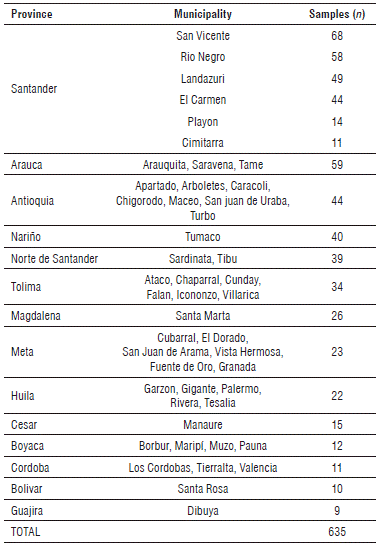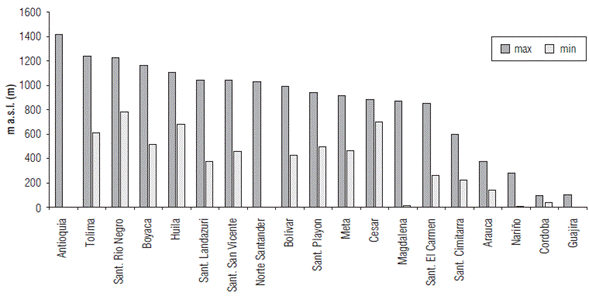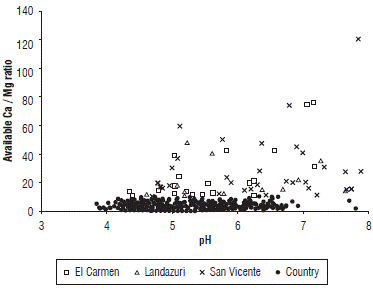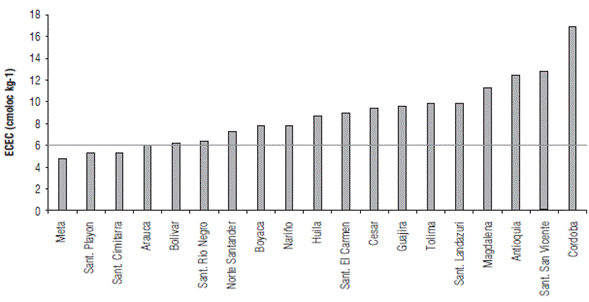Introduction
In Colombia, cacao plantations have a significant socioeconomic importance because they are cultivated in rural areas with high levels of poverty and the prevalence of social conflicts. Traditionally, cacao beans are not only commercialized but are also consumed as part of the rural and urban diets, even more than coffee (García-Cáceres et al., 2014). Cacao production depends on family labor and its cultivation and processing is generally an additional activity from a diversified farm system and might not be the main economic activity (Espinal et al., 2005; Petterson, 2016). However, it is estimated that more than 52,500 families depend directly on cacao for their livelihood (Baquero, 2018). The Colombian government expects this cropping system to generate a significant contribution to the illicit crop substitution process that is currently being carried out.
Although nearly 660,000 ha have been identified for planting cacao without any agricultural restriction, cacao must compete with other crops for prime areas and is generally not planted (García-Lozano, 2004; García-Cáceres, 2014).
Thus, this crop is usually planted in areas with edaphoclimatic limitations that may restrict its productive potential (García-Lozano, 2004; Méndez et al., 2006). Limitations include low water or nutrient availability, soil acidity, and mechanization difficulties, among others. These constraints partially explain the low national yields which do not exceed 500 kg ha-1/yr, despite research and development efforts made in the country by research and developmental institutions (Agrosavia and universities) and private commercial entities (Fedecacao, Casa Luker, Nutresa). Available planting materials do not express their potential productivity because small and medium-scale producers do not perform timely fertilization (Álvarez-Carrillo et al., 2015), pest or disease management (Jaimes et al., 2011). The price of sustained fertilizers increases over the years, which discourages their use (Álvarez-Carrillo et al., 2015).
Despite the lack of management, cacao in Colombia is mostly classified as fine or flavored (Fedecacao, 2019) and recognized in annual showcase events, such as the Salon du Chocolat in Paris, France (IICO, 2016). This privileged condition, which only applies to 5% of the world cocoa production, is one more reason to promote and increase bean production. Application of fertilizers and soil amendments to improve production is essential to make the cacao cultivation more profitable and sustainable. The main objective of this study was to propose benchmark soil fertility conditions for Colombia as a guide for the establishment and maintenance of productive and sustainable plantations.
Materials and methods
A national cacao production survey was carried out between 2011 and 2013 in the largest cacao producing areas in Colombia. Based on the information collected with this survey, a physicochemical soil sampling scheme (0 to 20 cm depth) was carried out in productive commercial crops of at least more than three years of age. The highest cacao producing municipalities are located in 14 provinces: Antioquia, Arauca, Bolivar, Boyacá, Cesar, Cordoba, Guajira, Huila, Magdalena, Meta, Nariño, Norte de Santander, Santander, and Tolima.
Statistical analysis
Sample size and statistical distribution were established according to the planted area per province. Sampling points selected per municipality, and sample size per province were considered in the equation for finite populations (planted area per province) (Eq. 1).
where:
N = Total population
Zα = 1.96 (with 95% confidence)
P = desired proportion (in this case 5% = 0.05)
q = 1-p (in this case 1-0.05 = 0.95)
d = precision (5%)
The sample sites were established using data from municipal agricultural evaluations (EVAS) carried out by MADR in 2011 (MADR, 2016). The numbers of samples assigned per provinces/municipalities are shown in Table 1. Six municipalities of Santander that represented the biggest cacao producing province were analyzed based on their specific weight in the national production. In total 635 cacao farms were sampled.
Sampling and laboratory analysis
Soil samples were taken from productive cacao plantations with a minimum of 3 years of establishment and yields higher than 600 kg ha-1 of dry cacao. Plots were selected with areas not bigger than 5 ha (average for cacao producers). Sampling was carried out in the soil area with the highest root density: the cacao plant crown (De Almeida and Valle, 2007) in plots of 50 m x 50 m, with at least four subsamples.
Physicochemical variables were analyzed at Agrosavia facilities, according to the following methods: pH (potentiometric method, soil-water ratio 1:2.5), exchangeable acidity (KCl 1N), interchangeable Al, texture by touch, organic matter (modified Walkley Black), P (Bray II), S (monocalcium phosphate), interchangeable bases (Ca, Mg, K, in 1M of ammonium acetate at pH 7) and ECEC (effective cationic exchange capacity by addition of cations). Moreover, bulk density was determined by undisturbed sampling with a known volume ring, and the particle density was obtained using the pycnometer method.
Results and discussion
The scope of this study corresponds to 635 soil samples (0-20 cm) taken between 2011 and 2013, each one from a productive cacao field, generally no bigger than 5 ha. Sampling was carried out in 13 of the 23 provinces in Colombia, representing the largest cacao producing areas in the country. Since six municipalities in Santander (El Carmen, Rio Negro, El Playon, Landazuri, Cimitarra and San Vicente) accounted for 32% of the cacao production in the country, each one was treated as if it was a province in the following graphs and tables (Tab. 1).
Cacao plantations ranged from 0 to 1,400 m a.s.l. (Fig. 1) and are considered representative of areas where cacao can be planted in Colombia. Depending on topography, there are provinces such as Antioquia and Norte de Santander where cacao is cultivated throughout the range of altitude, while in others (Nariño, Meta and Arauca) it is cultivated at a low altitude and relatively flat topographies. However, most of the cacao farms are located between 350 and 1,000 m a.s.l. (Fig. 1).
Most of these plantations are established in udic to mildly ustic soil moisture regimes. Additionally, they loosely correspond to forest biomes ranging from humid to dry tropical forest and/or well drained river terraces of mixed mineralogy, as they are located all along a north-south transect of the Andes Mountains of Colombia with very different parent materials. Plantation locations vary widely, but due to farmers' knowledge, they seemed to follow natural patterns of higher soil fertility rather than land availability. For example, in the province of Meta, despite having a very large quantity of available land, cacao farmers preferred a thin strip of higher fertility and better drained alluvial terraces (RV soil series) surrounding the Ariari river rather than the dominant acid soils in a piedmont landscape (PV soil series) and well drained plateaus dominated by acid soils (LV soil series) (Fig. 2).
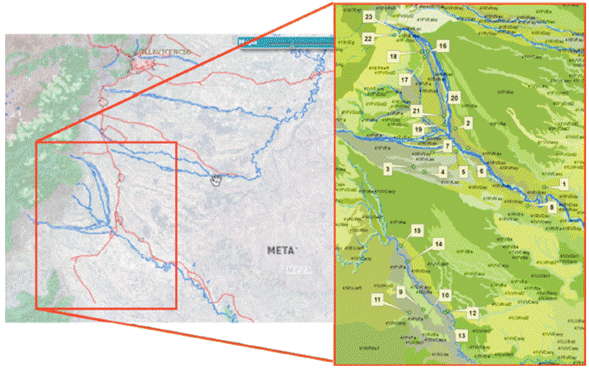
FIGURE 2 Spatial distribution of cacao farms sampled in the municipality of Granada, Meta, Colombia.
Soil texture (per province) ranged between 14 and 40% clay, and between 31 and 65% sand. Silt was the least variable textural component ranging between 20 and 44%. Predominant soil textures were loamy, clay-loam, sand-loam and loamy-sandy-clay (Fig. 3). With these textural ranges, real density averaged between 2.36 and 2.59 mg m-3 and bulk density between 1.07 and 1.28 mg m-3. Total porosity varied in a narrow range between 48.8 and 55.0%, with no evidence of compaction (data not shown). Mean SOM contents varied between 1.5 and 4.9% (Tab. 2), although the national value ranged between 0.3 and 13%. Only 28 samples had SOM values lower than 1%, and five samples showed values higher than 10%, mainly in Landazuri.
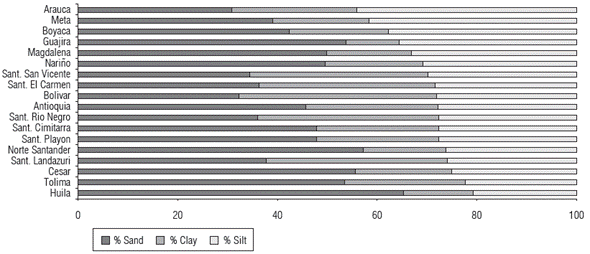
FIGURE 3 Average soil surface textures (0-20 cm, arranged by silt content decrease) of productive farms in the provinces/municipalities with the highest cacao production rates in Colombia from 2011 to 2013.
TABLE 2 Average physicochemical properties of cacao productive areas in Colombia from 2011 to 2013.
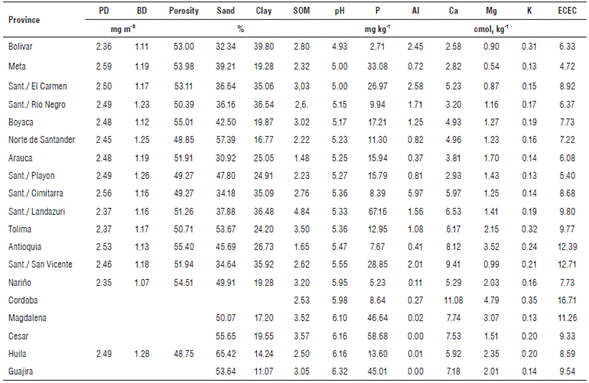
BD: bulk density, PD: particle density, SOM: soil organic matter, ECEC: effective cation exchange capacity.
The average physicochemical soil properties by province/municipality arranged by increasing mean pH are shown in Table 2. Because in Colombia small-scale producers were found to rarely use soil amendments or fertilization practices, a fact corroborated by the survey, and typical of small cacao farmers worldwide (Snoeck et al., 2016; Van Vliet et al., 2017), the values presented are representative of soils without mayor amendments or fertilizer practices.
Reference soil nutrient content proposed for cacao in Colombia (García-Lozano et al., 2004) and other producing countries (Wessel, 1971; Paramananthan, 2000; Snoeck et al., 2016) are shown in Table 3. These reference values are meant as a guide to intensify cacao productivity.
TABLE 3 Reference chemical parameter levels for cacao soils in Colombia and other countries.
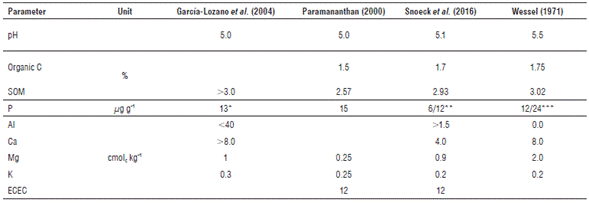

SOM: soil organic matter
*13 μg g-1 calculated based on an apparent density of 1.3 mg m-3 with 58 kg ha-1 of P2O5.
**Melick/Olsen extraction.
***sandy-clay soils.
The correlation matrix coefficients for soil chemical properties and calculated % saturations of Colombian soils are shown in Table 4. Of the evaluated parameters, pH, Al+3 and Ca+2 and their saturations showed the highest correlations. However, base and Al saturation (as percent of the ECEC) consistently showed the best correlation with coefficients greater than 75%.
TABLE 4 Correlation matrix of the chemical parameters evaluated for cacao productive areas cultivated by small-scale farmers in Colombia from 2011 to 2013.
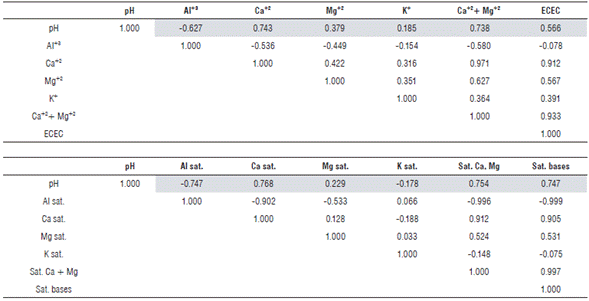
Statistical analysis indicated that the data were adjusted to normality assumptions for the generation of parametric linear models. As an example, the adjustment to the pH vs. Al saturation model shows that it is comprised of two parts: a linear adjustment with pH values<5.5, and a portion without adjustment for pH>5.5. For the linear portion, the atypical points suggested by the model were eliminated from the regression (8 points of 357 for the linear portion) (Fig. 4) and the correlation coefficient of R 2 = 0.7626 is improved to 0.7964. In this case, the linear model changes the intercept (pH) from 5.2070 to 5.2162, and the Al saturation coefficient (X) changed from -0.01175 to -0.0120.
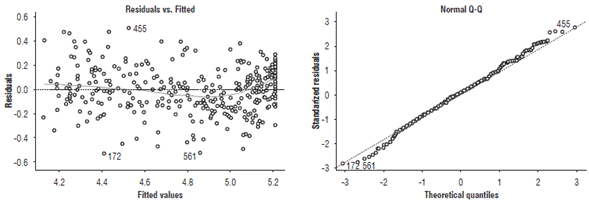
FIGURE 4 Normality assumptions of the data (n = 635) for the regression model of the relationship between pH and Al saturation in Colombian cacao soils.
The pH is one of the most indicative variables of the general condition of the soil (Fageria and Baligar, 2008). On average, the pH of soils under cacao per province varied from 4.9 to 6.1, but nationally ranged between 3.9 and 7.9 (Tab. 2). Some provinces such as Huila, Guajira and Magdalena showed a very narrow pH range, while Santander, Tolima, Antioquia and Meta showed pH ranges higher than 2.43.5 in relatively small regions, which are similar in magnitude to the national values (Fig. 5). Only Bolivar, Meta, Santander/El Carmen, Santander/Rio Negro and Boyacá had mean province values lower than 5.2, which indicate fields prone to high aluminum content. As an indicator, a pH>5.0 seems reasonable for Colombia allowing for some aluminum tolerance for the currently available materials.
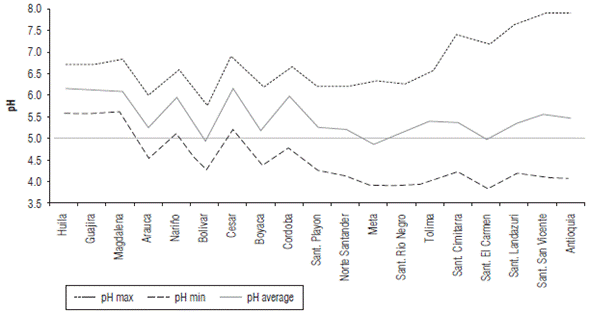
FIGURE 5 pH range of the soils under representative cacao productive areas cultivated by small-scale farmers in Colombia (ordered from low to high range) from 2011 to 2013.
The available phosphorus content (Bray II) in the country was between 0.1 and 334.9 mg kg-1. Province range varied between 2.7 and 67.2 mg kg-1 (Tab. 2). No correlation was found between available P content and pH (R 2 = 0.068) or another chemical parameter. Moreover, of the total number of samples taken, only 47 samples had levels below 2 mg kg-1 (Fig. 6) and 25 samples had levels higher than 108 mg kg-1 (not shown in Fig. 6). For Colombia, a minimum of 12 mg kg-1 of available P is proposed, which corresponds approximately to the maximum level of P found in soils with some Al content (pH<5.5) (Tab. 5).
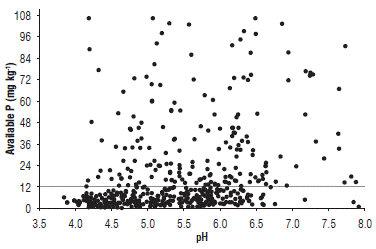
FIGURE 6 Dispersion of available P contents in the pH range of soils under representative cacao productive areas cultivated by small-scale farmers in Colombia from 2011 to 2013.
TABLE 5 Minimum levels of chemical conditions in Colombian soils for the development of productive cacao projects.

Our proposal fits the limits suggested for other countries (Tab. 3). From the samples analyzed, 64.4% showed some level of deficiency. On average, seven municipalities/ provinces showed values below the suggested levels. In these cases, P fertilizer application is required to obtain a competitive production.
Al+3 saturation was highly correlated with soil pH rather than with the available Al content (R 2 = -0.747 vs. -0.627 respectively, Tab. 4) (Fageria and Baligar, 2008). From the national model of pH vs % Al saturation (R2 = -0.828, Tab. 5), 76% of the model linearly predicts Al content in the range of pH>5.2-5.5, (Al% = 346.04 - 65.022*pH). For higher pH (pH<5.5), no correlation was found (R2 = 0.0152) (Fig. 7).
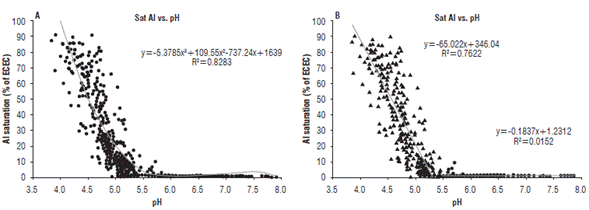
FIGURE 7 Relationship between pH and Al saturation under representative cacao productive areas cultivated by small-scale farmers in Colombia from 2011 to 2013: a) model of full pH range; b) two phase model as per %Al content at pH=5.5.
We propose that for soils with <20% of Al+3 saturation, equivalent to >1.5 cmolc kg-1 of available Al+3, and with genetic materials with low Al+3 susceptibility, damage should not be expected at the root level, and additional amendments may not be required for adequate production at least in the initial years (Ribeiro et al., 2013). However, amending the Al+3 component will improve the efficiency of applied fertilization (Puentes-Páramo et al., 2014; Rosas-Patiño et al., 2017) in Typic Udorthents soils of the Colombian Amazon, dolomite lime was applied at levels of 7 mg ha-1 which reduced the exchangeable Al+3 levels improving nutrient availability and productivity. A minimum pH value of 5.0 is proposed as a predictor of a chemical condition of the soil for cacao cultivation in Colombia (Tab. 5). Of the national samples, 9% showed Al+3 contents that merit correction. As a province average, only Meta and Bolivar showed pH values in a lower range. However, Bolívar and the Santander municipalities of El Carmen and Rio Negro exhibited Al saturation % higher than 20%, suggesting that some type of amendment would be necessary (Tab. 2).
Ca saturation (% of ECEC) showed relationships similar to Al, which best explains the relationship with pH (R2 = 0.75 vs. 0.63, respectively); however, it continues to be predictive beyond pH 5.5 (Fig. 8).
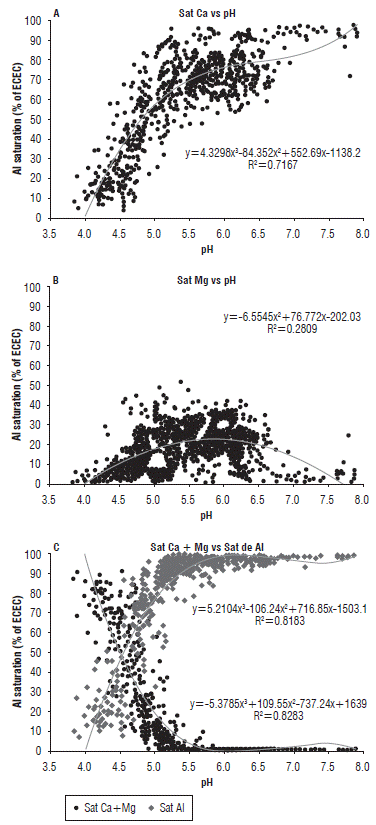
FIGURE 8 Relationship between pH: A) Ca saturation; B) Mg saturation; C) Ca+Mg saturation vs. Al saturation under representative cacao productive areas cultivated by small-scale farmers in Colombia from 2011 to 2013.
For cacao cultivated soils with a pH >5.0, Ca levels or its % saturation were at least 4.0 cmolc kg-1 or 60% saturation, respectively. These levels are proposed as indicators of the minimum soil Ca content or saturation for cacao soils in Colombia (Tab. 5), which corresponds to the lower limit of the levels proposed for other countries (Tab. 3). However, with the available Mg levels or its saturation no correlation was found with pH or other soil parameters (R 2 = 0.29 vs. 0.27, respectively) (Fig. 8). But the addition of Mg to the Ca contents relationship (Ca + Mg) did provide a greater precision. The suggested levels of available Mg for cacao according to the literature (Tab. 3) varied between 0.25 and 1.0 cmolc kg-1. For the Colombian soils, an Mg content of 1.0 cmolc kg-1, equivalent to 16% Mg saturation (Tab. 5) implies that 74% of Colombian soils show Mg deficiency.
We interpret this level to be a higher limit to be used for soils with pH>5.5 and high ECEC. However, a lower limit of 0.50 cmolc kg-1 is suggested to be used for soil with a pH<5.5 (and lower ECEC) and equivalent to approximately 10% Mg saturation. From the available Mg requirements (Tab. 3), only Paranamantan (2000) proposed a lower level of 0.25 cmolc kg-1. The Mg requirements of productive cacao soils need to be an area of active research in Colombia.
The Ca/Mg ratio did not show any correlation with any chemical soil parameter (Fig. 9). The literature review does not report this parameter as an important indicator for cacao (Hartemink, 2005; Snoeck et al., 2016). Thirteen percent of the country's samples have a wide Ca/Mg ratio of >10 (Fig. 8). These soils are found mainly in the municipalities of El Carmen, San Vicente and Landazuri, all located in Santander. No apparent production problems are reported at these sites.
For available K, the range was between 0.002 and 1.9 cmolc kg-1 with a national average of 0.2 cmolc kg-1. The province range varied between 0.13 and 0.35 cmolc kg-1. No correlation was found between the content of available K and pH (R 2=0.0304) or another physicochemical soil parameter (Fig. 10). The level of 0.20 cmolc kg-1 for Colombia, equivalent to about 5% of the base saturation, is suggested as suitable for cacao (Tab. 5). These levels are similar to those suggested in other studies (Tab. 3). At this level, 70% of the Colombian cacao samples appear to have some level of deficiency.
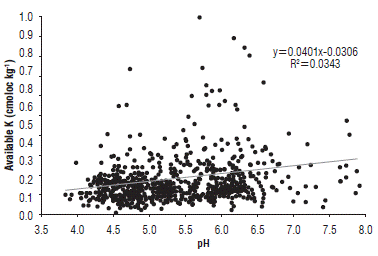
FIGURE 10 Available K content in the pH range of soils under representative cacao productive areas cultivated by small-scale farmers in Colombia from 2011 to 2013.
Cation exchange capacity (CEC, measured at pH 7.0) was not evaluated, but the effective cation exchange capacity (ECEC) which is the sum of cations at soil pH is proposed as a proxy indicator of the capacity to supply bases. ECEC was considered since it varies depending on the type and percentage of clay, the pH and the content of organic matter; and can hardly be changed permanently (Brown and Lemon, 2007). ECEC is proposed as a good indicator since cacao production is demanding on bases. The provinces ECEC range varied between 4.7 and 16.7 cmolc kg-1. The national range was between 1.1 and 33.2 cmolc kg-1 with a national average of 8.8 cmolc kg-1. A minimum level of 6.0 cmolc kg-1 is proposed for Colombia (Fig. 11), a much lower level than the proposed ones for other countries.
Conclusions
Based on the national survey carried out in this study, minimum physicochemical soil variables levels for productive cacao projects are proposed in Table 5. Under prevailing conditions, conditions, small cacao farmers of Colombia have a high probability of having at least two nutritional deficiencies: P and K, and their correction is essential to increase productivity.
These suggested minimum levels are benchmarks for assessing the needs of an established crop or for starting new ventures in which medium to high productivity yields are expected: those that can produce sustainably at least 1.2 to 1.5 t ha-1, which is the national goal for Colombia, are used as reference to apply for bank loans for successful productive projects (García-Cáceres et al., 2014). Of course, other additional factors must also be considered, such as environmental conditions and other soil conditions such as the water table and the absence of waterlogging conditions, as well as the proximity to collection centers.
With these minimum levels, plus an adequate agronomic fertilization management and sanitary control, it is possible to develop a productive and competitive cacao production for the social development of the country.














